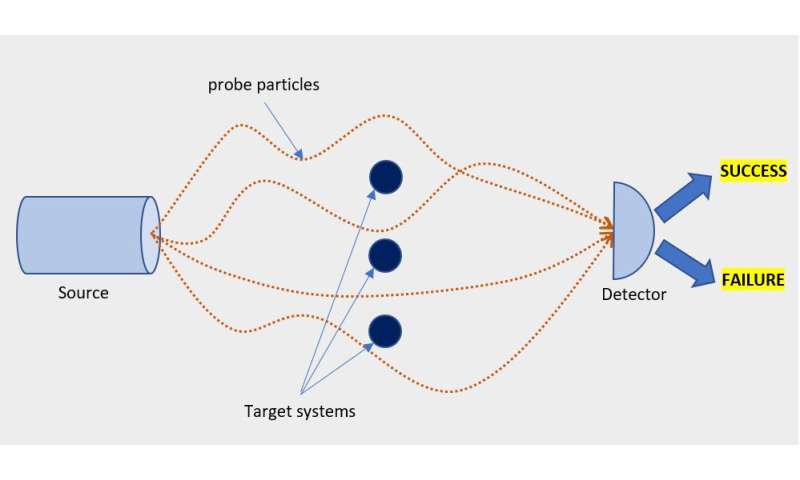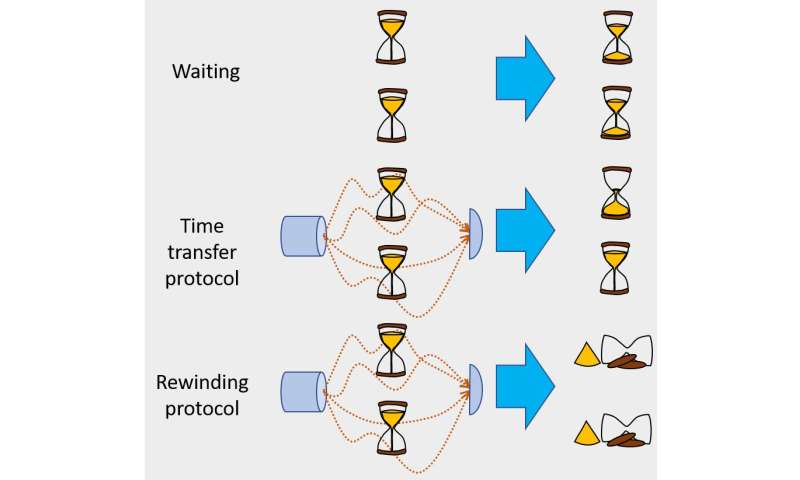Physicists invent a machine that translates quantum systems in time

Popcorn and chocolate bars aside, there is a big difference between watching a movie in the cinema and viewing it at home. In the cinema, the movie runs from beginning to end, irrespective of the audience's will. At home, the remote control gives us the power to manipulate the movie's progress. We can make the movie return to a past scene or jump several scenes ahead. We can stop the movie in its tracks and even play it slowly till the end.
But is it possible to build a remote control to rewind and fast-forward reality itself? In our recently published paper "Translating uncontrolled systems in time," my research group at the Institute of Quantum Optics and Quantum Information explores this question from the point of view of quantum mechanics. Our answer: With current quantum technology, it is possible to accelerate, decelerate and even invert the flow of time within arbitrary quantum systems, even uncontrollable ones.
Physical systems dominated by the laws of quantum mechanics, such as light, atoms and molecules, change with time. The configuration that such systems have at a given instant of time is called a state. For example, the quantum state of a photon (the particles that light is made of) determines the probability that it goes through a polarizing crystal set at any given angle. The maximum number of distinguishable states of a quantum system is called its dimension.
Our time translator works by making the target systems scatter a beam of probe particles (e.g., positrons), which are later subject to a quantum observation (see Figure 1). Depending on the outcome of this observation, the experiment is regarded as either a success or a failure. If the experiment succeeds, then the state of each of the target systems is guaranteed to undergo the desired time translation.
Notably, this time translation process is universal. That is, it occurs independently of how the targets interact with the probes. This property, universality, sets our results apart from other attempts to harness time in quantum systems. Our scattering protocols can translate in time even target systems that we can't control in the lab, a fact that is extremely counterintuitive—so counterintuitive, actually, that some colleague physicists couldn't quite believe it!
The secret of this puzzling phenomenon is in the careful preparation and observation of the particle beam. While it goes through the targets, the particles making up the probe beam are correlated with the target systems in a way that has no classical analog; in physics terminology, we would say that targets and probes become entangled. The final measurement or observation to which the probes are subject is also fundamentally quantum: Unlike in classical physics, it cannot be conducted by measuring each probe individually. Different preparations and observations of the beam correspond to different time translations for all target systems of a given dimension that interact with the beam in any way.

However, if the scattering experiment is limited in time, then not every time translation is allowed by the laws of quantum mechanics. Which times the target systems can jump to are limited by three rules:
- Time cannot be created. Think of a single target system. What this rule means is that, in five seconds, it is impossible to make the target age 500 seconds: That would imply creating 500—5 = 495 seconds out of nowhere.
- Time can be transferred at no cost. Consider 100 target systems. This rule states that it is possible to devise a scattering experiment of five seconds duration that transfers the whole time accumulated in five seconds by the 100 particles—namely, 5 × 100 = 500 seconds—to one of the targets. At the end of this five-second experiment, the selected target would have aged by 500 seconds; the remaining targets would be in the same state they had at the beginning of the experiment.
- Time can be inverted at a cost equal to the dimension of the target minus one. In other words: If we have a single target system of dimension 14, in order to rewind it by five seconds, we need to conduct an experiment lasting at least (14 - 1) × 5 = 65 seconds. Combining rules two and three, though, it is possible to engineer a 65-second experiment for 100 target systems of dimension 14 that inverts all the time accumulated by the 100 systems and then transfers it to a single system. The selected target would then be propagated to the state that it had 5 × 100 = 500 seconds before the experiment took place.
The three rules just leave room for three types of time translations, illustrated in Figure 2: waiting, time transfer and rewinding.
Even though our results are theoretical, our simplest scattering protocols for time translation turn out to be within reach of current quantum technology. In fact, one of our schemes to time-translate target systems of dimension 2 has already been implemented successfully. In the experiment, carried at the Shanghai Research Center for Quantum Sciences, a universal rewinding effect was demonstrated by resetting the polarization state of a photon. As the theory predicted, the final state of the photon was verified to be very close to the state that it had some time before the device acted on the particle. More sophisticated experiments, achieving optimal rewinding speed, are being carried out at the University of Vienna as at the time of writing.
What we have, therefore, is a remote control that, rather than changing the pace of a recording of quantum systems, acts on the quantum system's actual motion. We are all very excited, theorists and experimentalists alike. The subject of time translation has captivated human imagination for centuries, and the remote possibility of ever constructing a time machine inspired some of us to pursue physics studies in the first place. It is too soon to tell what future developments these findings will bring. However, one thing is for sure: Science fiction has reached the lab.
This story is part of Science X Dialog, where researchers can report findings from their published research articles. Visit this page for information about ScienceX Dialog and how to participate.
More information: David Trillo et al. Translating Uncontrolled Systems in Time, Quantum (2020). DOI: 10.22331/q-2020-12-15-374
Zheng-Da Li et al. Photonic realization of quantum resetting, Optica (2020). DOI: 10.1364/OPTICA.389322
Miguel Navascués is a group leader at the Institute for Quantum Optics and Quantum Information in Vienna, Austria, where he conducts research on quantum information science and the foundations of quantum physics.